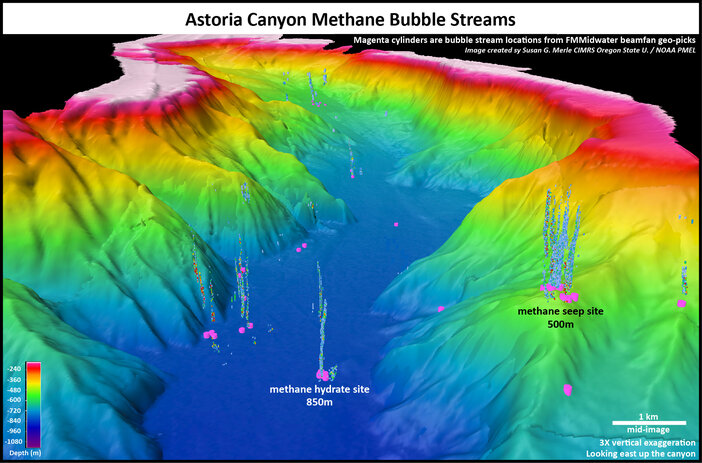A research paper has shed new light on the extent and distribution of seafloor methane seeps in the northeast Pacific Ocean, which provide important habitats for marine life and could play an important role in ocean warming.
The paper, by scientists from the Oregon State University-NOAA Cooperative Institute for Marine Resources Studies (CIMRS), University of Washington, US Naval Research Lab at Stennis Space Center, and Ocean Exploration Trust, analyzed data on the seafloor from the Strait of Juan de Fuca in the north to the Mendocino Fracture Zone off northern California in the south, in an area known as the Cascadia Margin.
The West Coast continental shelf is known to host methane bubble streams, formerly thought to be rare. However, the results indicate that nearly 3,500 methane bubble streams, clustered into more than 1,300 methane emission sites, emanate from the seafloor from the Strait of Juan de Fuca.
Methane bubbles emanating from beneath a solid methane hydrate ledge on the floor of Astoria Canyon, offshore Oregon at 850 meters (2,790 feet) water depth. Video courtesy of the Ocean Exploration Trust; edited by Bob Embley
The paper used data collected during multibeam mapping surveys on Exploration Vessel (E/V) Nautilus supported by NOAA Ocean Exploration, as well as the Research Vessel (R/V) Thompson and NOAA Ship Rainier and historical data.
The results provide a major contribution to the first systematic “baseline” survey of methane seeps published over such a large area, representing over 40% of the 93,000 square kilometers (35,900 square miles) of the US Cascadia margin.
Methane seeps host chemosynthetic communities, build rocky carbonate hard grounds that are essential fish habitat, and release an unknown quantity of methane to the ocean and potentially to the atmosphere, where it acts as a powerful greenhouse gas. This new seep compilation provides a baseline to evaluate possible future increasing methane gas flux as ocean waters warm and drive what is known as the methane hydrate stability zone deeper, releasing additional methane from its ice-like form.
In summer and fall 2021, some of the co-authors and other members of NOAA Pacific Marine Environmental Laboratory (PMEL), University of Washington, and Oregon State University will participate in another Nautilus Cascadia Margin expedition as well as in the West Coast Ocean Acidification expedition aboard NOAA Ship Brown. More data will be acquired for addition to this new database in order to better understand any potential impacts of methane seeps in the water column and to test new technologies.
To read the full paper, which was published in Frontiers of Earth Science, click here.



